Memory Frequency Scaling in SFF Systems: An Investigation with SO-DIMMs and Coffee Lake
by Ganesh T S on November 28, 2018 8:00 AM ESTBAPCo SYSmark 2018
The different ASRock DeskMini Z370 GTX configurations were evaluated using our Fall 2018 test suite for small-form factor PCs. In the first performance section, we will be looking at SYSmark 2018.
BAPCo's SYSmark 2018 is an application-based benchmark that uses real-world applications to replay usage patterns of business users in the areas of productivity, creativity, and responsiveness. The 'Productivity Scenario' covers office-centric activities including word processing, spreadsheet usage, financial analysis, software development, application installation, file compression, and e-mail management. The 'Creativity Scenario' represents media-centric activities such as digital photo processing, AI and ML for face recognition in photos and videos for the purpose of content creation, etc. The 'Responsiveness Scenario' evaluates the ability of the system to react in a quick manner to user inputs in areas such as application and file launches, web browsing, and multi-tasking.
Scores are meant to be compared against a reference desktop (the SYSmark 2018 calibration system, a Dell Optiplex 5050 tower with a Core i3-7100 and 4GB of DDR4-2133 memory to go with a 128GB M.2 SATA III SSD). The calibration system scores 1000 in each of the scenarios. A score of, say, 2000, would imply that the system under test is twice as fast as the reference system.
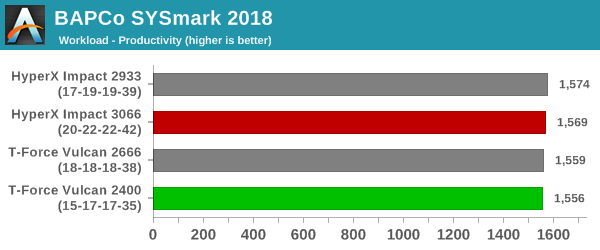
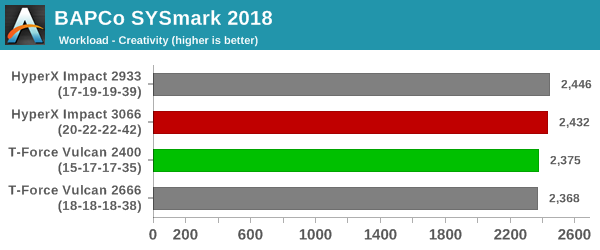

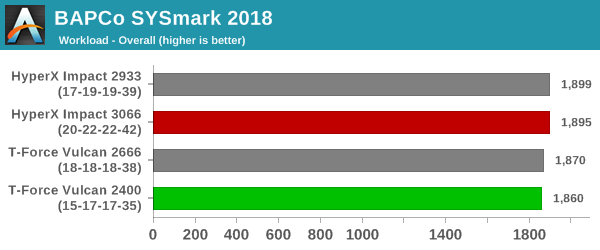
Other than the responsiveness workload, the DDR4-2933 configuration ends up with the best scores. This correlates well with the minimum latency observed in the AIDA64 Cache and Memory Benchmark testing. The scores generally follow the expected trend, and in cases where they don't, they are within the margins of variation observed in multiples runs with the same configuration.
SYSmark 2018 also adds energy measurement to the mix. A high score in the SYSmark benchmarks might be nice to have, but, potential customers also need to determine the balance between power consumption and the efficiency of the system. For example, in the average office scenario, it might not be worth purchasing a noisy and power-hungry PC just because it ends up with a 2000 score in the SYSmark 2014 SE benchmarks. In order to provide a balanced perspective, SYSmark 2018 also allows vendors and decision makers to track the energy consumption during each workload. In the graphs below, we find the total energy consumed by the PC under test for a single iteration of each SYSmark 2018 workload. For reference, the calibration system consumes 5.36 Wh for productivity, 7.71 Wh for creativity, 5.61 Wh for responsiveness, and 18.68 Wh overall.
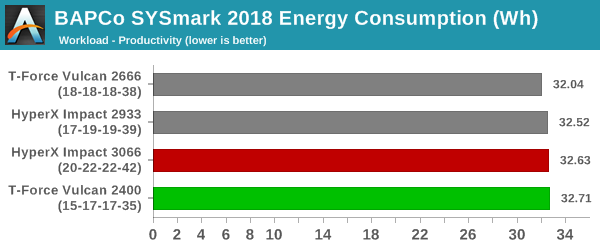
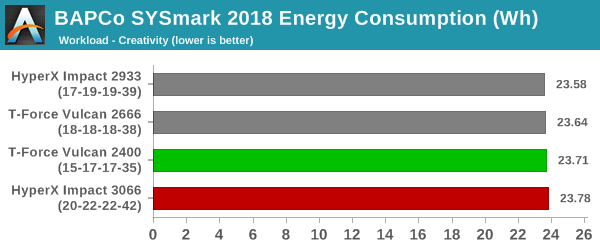
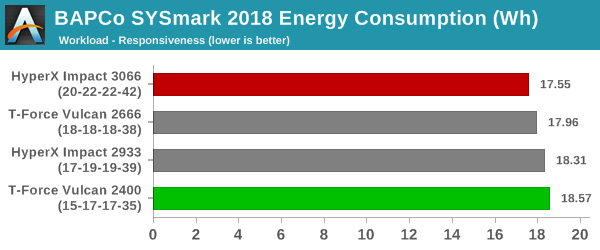
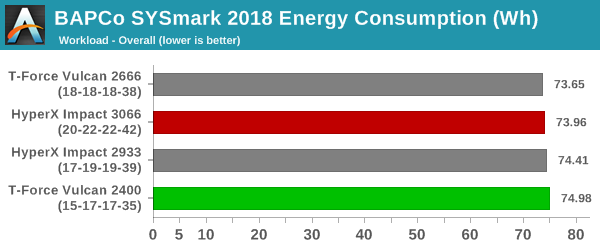
The energy consumption is not reflective of the average power consumption at load or idle. Rather, the faster the benchmark is able to complete, the lesser is the energy recorded for the workload. This is the reason for the DDR4-3066 configuration (expected to be the most power-hungry of the lot) consuming the least energy in the 'Responsiveness' workload. Overall, the DDR4-2400 configuration fares the worst due to the workloads needing a longer time to complete. The DDR4-2666 configuration seems to achieve the best balance of power consumption and speed.










25 Comments
View All Comments
cygnus1 - Wednesday, November 28, 2018 - link
How does anyone look at those memory benchmarks and justify buying anything other than the cheapest RAM that meets minimum spec?Yuriman - Wednesday, November 28, 2018 - link
Pretty much agree. Good to know, though.nwrigley - Wednesday, November 28, 2018 - link
Yep. The only difference for me is that I only buy Crucial. This comes from personal experience of AMAZING customer support from them.I had one of their sticks die on me once after 8 years of use. I called in and was shocked to talk to someone in the US. Since they didn't make the same RAM I had anymore, they offered to replace all 4 sticks so that I had a matching set, even though 3 of the 4 sticks were fine. And since the replacements were slower timings without heat spreaders, they offered to double the capacity to cover the difference. They upgraded me from 4x 1-gig sticks of DDR2 to 4x 2-gigs of DDR2 without me raising any fuss - this was all customer services idea. That made me a customer for life.
cygnus1 - Wednesday, November 28, 2018 - link
Yeah, I too am a big Crucial fan because of reasons like this, from my experience as well. Not quite as generous as your story, but never any kind of trouble getting support for their hardware.But these benchmarks really show that performance should not be even remotely near the top of the list of reasons to pick one RAM part over another. Brand/warranty/customer service is a real way to differentiate and justify a given price.
koaschten - Wednesday, November 28, 2018 - link
I found this handy graphic on reddit some time ago:https://i.imgur.com/lbPIkiW.png
Looking at the tested offerings, it is obvious why there was so little performance gain, the Latency/clock relations are just off the chart, for the 3066 CL20 literally.
koaschten - Wednesday, November 28, 2018 - link
source: https://www.reddit.com/r/intel/comments/9mlwbn/ram...yes, this is DIMM not SO-DIMM, but shows the differences nicely.
willis936 - Wednesday, November 28, 2018 - link
It is somewhat frustrating to see all of this work done on a case that doesn't make sense to examine first.If the original question is "When does memory performance matter to CPUs?" then the place to start is at the extreme, not somewhere in the middle. If it was found that an 8 core 4 GHz x86 processor with whatever cache architecture and two channels of memory was memory bandwidth or latency starved THEN it would make sense to start moving down the stack and identify when it is no longer a concern. The conclusion to draw from this is much less meaningful to most any reader. There are like five people on the planet choosing between more expensive and cheaper memory kits for SFF systems.
GreenReaper - Thursday, November 29, 2018 - link
Might make more sense with AMD APUs. You'd probably get a much better return from overclocking the memory than the CPU, given how bandwidth-starved they can be.The_Assimilator - Wednesday, November 28, 2018 - link
Whatever happened to ranking memory by its performance rating, to determine how objectively good it is? For anyone who doesn't know/remember, performance rating = (memory frequency / CAS latency), and higher = better.It's sad that in this day and age, my 2x8GB DDR3-1600 CL8 (with no RGB LEDs or unnecessary heatsinks) has a higher PR than any of these DDR4 kits. It's even sadder that today's reviews of memory that "overclock" it, just concentrate on pushing up the frequency instead of trying to tighten the CAS timings, because the latter is where you'll see the most benefit.
nevcairiel - Wednesday, November 28, 2018 - link
All you are calculating here is the actual latency, since CAS latency is expressed in cycles. What this doesn't account for is the actual memory speed (ie. bandwidth).Just using your formula, a 1600/8 and 3200/16 module should be equal, right? But one of those offers twice the raw memory throughput, at about similar absolute latency (ie. performance rating).
It is a good idea to keep in mind that latency and frequency interact, but not in a way you suggest. Many people look at things like 3200 CL16 and 3600 CL18 and would instinctively say that the second set has a higher latency, while in reality the actual latency is quite similar, and you get more bandwidth.